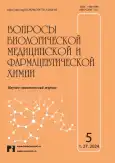Influence of cultivation conditions on the growth and accumulation of biologically active substances of Hyssopus officinalis L. under in vitro conditions
- Authors: Cherednichenko М.Y.1, Khlebnikova D.А.1, Fedotova P.А.1, Brem Е.S.2, Romanenko V.А.2
-
Affiliations:
- Russian State Agrarian University – Moscow Timiryazev Agricultural Academy
- Ltd. «Natura Siberica»
- Issue: Vol 27, No 5 (2024)
- Pages: 50-58
- Section: Pharmaceutical chemistry
- URL: https://journals.eco-vector.com/1560-9596/article/view/633132
- DOI: https://doi.org/10.29296/25877313-2024-05-06
- ID: 633132
Cite item
Abstract
Introduction. Since ancient times, aromatic plants have been widely used to treat diseases of various natures due to the content of valuable metabolites and essential oils (EOs). In modern medicine, cosmetology and the food industry, the importance of aromatic plants is also not in doubt; the chemical composition, accumulation features, synthesis and properties of EO are being actively studied. With the development of clonal micropropagation technology, it has become relevant to study the accumulation of biologically active substances in aseptic in vitro culture (microclones and cell cultures) under various propagation protocols.
Material and methods. Hyssop (Hyssopus officinalis L.) is a common aromatic plant from the family Lamiaceae Martinov. The aerial parts and EO of the plant have a wide range of biological activities - anti-inflammatory, antioxidant, antimicrobial, etc., which determines the use of plant biomass and extracts in food and light industries, medicine, and pharmacology. In this work, the influence of the mineral and hormonal composition of nutrient media on the growth of aseptic plants of two cultivars of Hyssopus officinalis – Lekar and Iney – was studied.
Results and conclusion. A comparison was also made of the accumulation of the total flavonoids in an aseptic culture depending on the cultivation mode - the degree of aeration of the culture vessel and the addition of cytokinin or auxin components to the nutrient medium. It was found that the leaves of aseptic plants of Hyssopus officinalis accumulate more flavonoids (up to 3.6 mg/g fresh weight) than the stems (0.3–1.1 mg/g fresh weight for most experimental variants), in addition, the cv. Lekar was significantly richer in compounds of this group (2.7–3.6 mg/g fresh weight in leaves) compared to the cv. Iney (no more than 1.5 mg/g fresh weight in leaves).
Full Text
About the authors
М. Yu. Cherednichenko
Russian State Agrarian University – Moscow Timiryazev Agricultural Academy
Email: cherednichenko@rgau-msha.ru
Ph.D. (Biol.), Associate Professor, Acting Head of the Department of Biotechnology
Russian Federation, MoscowD. А. Khlebnikova
Russian State Agrarian University – Moscow Timiryazev Agricultural Academy
Author for correspondence.
Email: khlebnikova@rgau-msha.ru
Ph.D. (Biol.), Assistant Professor of the Department of Biotechnology
Russian Federation, MoscowP. А. Fedotova
Russian State Agrarian University – Moscow Timiryazev Agricultural Academy
Email: polifedou@yandex.ru
Student
Russian Federation, MoscowЕ. S. Brem
Ltd. «Natura Siberica»
Email: e.brem@1reshenie.ru
Director of Research and Development Department
Russian Federation, MoscowV. А. Romanenko
Ltd. «Natura Siberica»
Email: v.romanenko@1reshenie.ru
Technologist-Developer
Russian Federation, MoscowReferences
- Bakhtenko E.Yu., Kurapov P.B. Mnogoobrazie vtorichnyh metabolitov vysshikh rastenij. Vologda: Izd-vo Vologodskij gos. ped. un-t. 2008; 266 p.
- Tarakhovskij Yu.S., Kim Yu.A., Abdrasilov B.S. I dr. Flavonoidy: biohimiya, biofizika, medicina. Pushchino: Sunchrobook, 2013; 310 p.
- Eibl R., Senn Y., Gubser G. et al. Cellular agriculture: opportunities and challenges. Annual Review of Food Science and Technology. 2021; 12(1): 51–73.
- Gubser G., Vollenweider S., Eibl D. Food ingredients and food made with plant cell and tissue cultures: State-of-the art and future trends. Engineering in Life Sciences. 2021; 21: 87–98.
- Grebennikova O.A., Palij A.E., Khlypenko L.A. i dr. Biologicheski aktivnye veshchestva Hyssopus officinalis L. Orbital'. 2017: 1: 1–8.
- Logvinenko L.A., Khlypenko L.A., Marko N.V. Aromaticheskie rasteniya semejstva Lamiaceae dlya fitoterapii. Farmaciya i farmakologiya. 2016; 4: 34–45.
- Pungin A.V., Popova E.A., Lartseva L.O. Povyshenie sinteza vtorichnykih metabolitov v kul'ture borodatykh kornej H. officinalis. Vestnik Baltijskogo federal'nogo universiteta im. I. Kanta. Seriya: Estestvennye i meditsinskie nauki. 2022; 1: 98–107.
- Rabotyagov V.D. Izuchenie soderzhaniya efirnogo masla v razlichnykh organakh Hyssopus officinalis L. Byulleten' GNBS. 2017; 125: 46–49.
- Kotyuk L.A. Antimikrobnaya aktivnost' efiromaslichnyh rastenij semejstva Lamiaceae Lindl. otnositel'no Escherichia coli. Ukrainian Journal of Ecology. 2016; 1: 20–25.
- Jankovský M., Landa T. Genus Hyssopus L. – recent knowledge: A review. Horticultural Science. 2018; 29: 119–123.
- Mazzanti G., Lu M., Salvatore G. Spasmolytic action of the essential oil from Hyssopus officinalis L. var. decumbens and its major components. Phytotherapy Research. 1998; 12: 2–9.
- Mitic V., Dordevic S. Essential oil composition of Hyssopus officinalis L. cultivated in Serbia. Facta Universit. 2000; 2(2): 105–108.
- Ozer H., Fikrettin S., Kilic H. et al. Essential oil composition of Hyssopus offcinalis L. subsp. angustifolius (Bieb.) Arcangeli from Turkey. Flavour. Fragrance J. 2005; 20: 42–44.
- Shoja H.M., Shishavan H.K. Effects of different hormonal treatments on growth parameters and secondary metabolite production in organ culture of Hyssopus officinalis L. BioTechnologia (Pozn). 2021; 102(1): 33–41.
- Svoboda K.P., Salambosi B., Deans S.G. et al. Agronomical and photochemical investigation of Hyssopus officinalis L. Agric Sci Finl. 1993; 2(4): 29–33.
- Vallejo M.C.G., Herraiz J.G., Pérez-Alonso M. Volatile Oil of Hyssopus officinalis L. from Spain. Journal of Essential Oil Research. 1995; 7: 567–568.
- Protsenko M.A., Mazurkova N.A., Filippova E.I. i dr. Protivogrippoznaya aktivnost' ekstraktov rastenij semejstva Lamiaceae. Himiya rastitel'nogo syr'ya. 2021; 2: 181–190.
- Murashige T., Skoog F. A revised medium for rapid growth and bio-assays with tobacco tissue cultures. Physiol Plant. 1962; 15(3): 473–497.
Supplementary files









